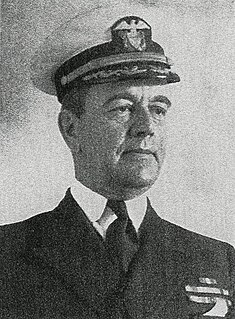
The Battle of Manila Bay, also known as the Battle of Cavite, took place on 1 May 1898, during the Spanish–American War. The American Asiatic Squadron under Commodore George Dewey engaged and destroyed the Spanish Pacific Squadron under Contraalmirante Patricio Montojo. The battle took place in Manila Bay in the Philippines, and was the first major engagement of the Spanish–American War. The battle was one of the most decisive naval battles in history and marked the end of the Spanish colonial period in Philippine history.
During the Spanish–American War of 1898, Cámara's Flying Relief Column was a naval task force of Spain's most powerful warships, under the command of Rear Admiral Manuel de la Cámara, tasked with relieving Spanish forces in Manila after the defeat of Spanish Pacific Squadron under Admiral Patricio Montojo y Pasarón by the American Asiatic Squadron under Commodore George Dewey in the Battle of Manila Bay on May 1, 1898. The Spanish fleet, consisting of the battleship Pelayo, armored cruiser Emperador Carlos V, auxiliary cruisers Patriota and Rapido, destroyers Audaz, Osado, and Prosepina, and transports Buenos Aires and Panay, left Spain in June 1898. The squadron was far more powerful than that commanded by Dewey, which only consisted of four protected cruisers and two gunboats. The monitor USS Monterey had been ordered from the U.S. to the Philippines, and departed on 11 June.

Rear Admiral Patricio Montojo y Pasarón was a career Spanish naval officer who commanded the restored Kingdom of Spain's Pacific Squadron based in the Philippines during the Spanish–American War. Considered to have been a man of high ability and experience, he was given what was regarded as an impossible task of defending the Spanish Philippines with antiquated ships and low supplies against the more formidable U.S. Asiatic Squadron. Montojo became known for his defeat at the Battle of Manila Bay by U.S. Navy Commodore George Dewey, being a decisive naval battle of the war. After the conflict, the rear admiral was held accountable for the defeat and was court-martialed, but that was later overturned, though Montojo was still discharged from the Spanish Navy.

Reina Cristina was an Alfonso XII-class unprotected cruiser of the Spanish Navy which fought in the Battle of Manila Bay.

Isla de Cuba was an Isla de Luzón-class second-class protected cruiser of the Spanish Navy which fought in the Battle of Manila Bay.

Isla de Luzón was an Isla de Luzón-class protected cruiser of the Spanish Navy which fought in the Battle of Manila Bay.
Marques del Duero was a Fernando el Catolico-class gunboat of the Spanish Navy which fought in the Battle of Manila Bay during the Spanish–American War.

Don Antonio de Ulloa was a Velasco-class unprotected cruiser of the Spanish Navy that fought in the Battle of Manila Bay during the Spanish–American War.

Velasco was a Velasco-class unprotected cruiser of the Spanish Navy which fought in the Battle of Manila Bay during the Spanish–American War.

Don Juan de Austria was a Velasco-class unprotected cruiser of the Spanish Navy that fought in the Battle of Manila Bay during the Spanish–American War.

Castilla was an Aragon-class unprotected cruiser of the Spanish Navy that fought in the Battle of Manila Bay during the Spanish–American War.

Emperador Carlos V was an armored cruiser of the Spanish Navy which served in the Spanish fleet from 1898 to 1933.

The Alfonso XII class of unprotected cruisers was a series of three ships built during the 1880s for service with the Spanish Navy. They were named for a Spanish king and two Spanish queens.

The Aragon class of unprotected cruisers was a series of three cruisers built between the late 1860s and early 1880s for service with the Spanish Navy. They were named for historic regions and kingdoms of Spain.
USS Don Juan de Austria was a U.S. Navy gunboat. Formerly a Spanish Navy unprotected cruiser, she was captured in 1898 during the Spanish–American War and commissioned into the U.S. Navy.

USS Isla de Cuba was a former Spanish Navy second-class protected cruiser of the same name, captured by and commissioned into the United States Navy as a gunboat.

USS Isla de Luzon was a former Spanish Navy second-class protected cruiser of the same name, captured by and commissioned into the U.S. Navy as a gunboat.

Dudley Newcomb Carpenter was a United States Navy officer and physician who participated in the Spanish–American War of 1898, and served through World War I and World War II. He established the first hospitals at Baguio, Philippines, Bas Obispo, Mexico and at Bremerton, Washington. He was also a writer.





















